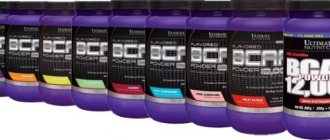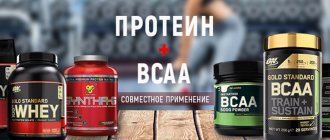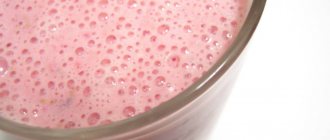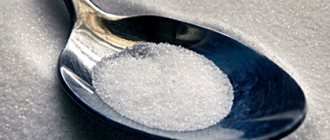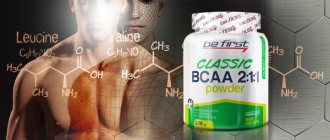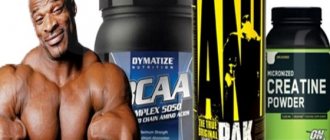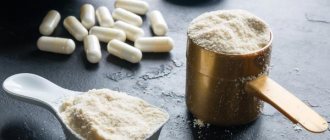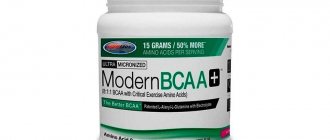The debate about which is better to choose, BCAA or protein, is still raging in the sports community. Both supplements are considered basic and are used on a regular basis. However, protein and BCAA have a number of differences that affect their use and effectiveness. It's time to figure out which supplement is more effective and in which case their maximum benefit is revealed.
Protein or BCAA (research review)[edit | edit code]
The benefits of using protein in bodybuilding and fitness are quite well substantiated in many studies. However, recently the advisability of using BCAA amino acids has increasingly been questioned based on the following facts:
1. BCAA is sufficient in a regular diet
The protein in the foods you eat throughout the day consists of approximately 18-26% BCAA. Foods containing BCAA and dietary proteins include, for example, meat, poultry, fish, eggs, milk and cheeses; The BCAA content in these products is approximately 15-20 g of BCAA per 100 g of protein.[1] Excessive consumption of BCAA poses a risk of exceeding the caloric intake of the diet.
However, taking BCAA is justified if the intake of these amino acids from food is insufficient, in particular with a low-calorie diet. It should be noted that the optimal level of BCAA intake has not been reliably established, but a dose-dependent correlation has been shown.[2]
2. BCAA have no benefits over whey protein
Whey protein has a stronger anabolic and anti-catabolic effect than amino acid complexes and BCAA used instead.[3]
Blood amino acid concentrations following intake of whey protein, leucine and essential amino acids.
EAA+LEU
- essential amino acids without leucine.
LEU
- leucine.
Whey
is whey protein.
The main advantage of BCAA compared to protein is often considered to be faster absorption. However, the graph on the right shows that the concentration of BCAA in the blood increases at approximately the same rate, both after taking these amino acids and after taking an equivalent amount of whey protein.
3. Research is unreliable.
Doubts about the effectiveness of BCAA have been noted in several studies.[4][5][6] Read a separate article: Research on the effects of BCAA.
Nutritional interventions to augment resistance training-induced skeletal muscle hypertrophy. Front Physiol. 2015 Sep 3;6:245.
“The use of powdered BCAA leads to a slowdown in the absorption of amino acids from the intestines and difficulty in their further entry into the muscles. BCAA supplements are less effective at enhancing muscle protein synthesis than leucine alone. Despite the popularity of BCAA supplements, we find very little evidence of their effectiveness in increasing muscle protein synthesis and/or lean muscle mass, and recommend the use of whole proteins - casein, whey, soy, egg, milk, rather than the purified combination of amino acids that constitute BCAA , which, when they enter the body, compete with each other during their transport into the blood from the intestine (competition for absorption channels in the intestine), which affects protein metabolism in general, and most likely the supply of amino acids to the muscles"
Translation: Dmitry Pikul
(corrected).
Alan Aragon in his publication also gives an example of defective study design and statistical processing [7].
4. BCAA are not economically viable
BCAA content of whey protein. Source: Dmitry Pikul (znatok-ne)
BCAA is only 3 essential amino acids, while a complete protein contains the entire amino acid profile: essential + non-essential.
- 1 gram of high-quality protein contains about 180-260 mg of BCAA (18-26%)
- 10 grams already contain 1.8-2.6 g,
- in 50 grams - 9-13 grams are BCAA
- in 100 grams of protein - 18-26 grams;
That is, to get 1 g of BCAA, you need to consume from ~4 to ~5.5 grams of complete protein.
The range of prices for sports nutrition is quite large, and the average price for 1 g of whey protein (depending on its quality and the manufacturer) varies from ~1 rub/g to ~3 rub/g as of 2022. The cost of 1 g of BCAA only, at current prices in Moscow, is at least 3 rubles/g and higher (up to values more than 2 times higher).
Those. We find that 1 g of BCAA costs almost three times more than 1 g of whey protein with a complete amino acid profile and a normal amino acid ratio.
5. Harmful by-products during production
Amino acid production occurs in four main ways:
- Extraction from hydrolyzate
- Biosynthesis or biofermentation (amino acids are produced by mutant strains of bacteria)
- Chemical synthesis
- Enzymatic synthesis (synthesis using purified enzymes)
Chemical and enzymatic synthesis for BCAA is practically not used. Bacterial biosynthesis is widely used in food products.
Currently, BCAA's for food use are produced mainly by biofermentation. Leucine, isoleucine and valine are produced by E. coli and C. glutamicum strains through the pyruvic and aspartic acid pathway. [8] Thus, isoleucine and valine are actually by-products of the synthesis.
The biofermentation method increases the cost of amino acids by 300-400% compared to chemical hydrolysis.[9]
Chemical hydrolysis.
In the process of producing food amino acids, plant sources (soybeans, grains) and animal sources (milk proteins) are used. Electrodialysis and several other methods can be used to obtain amino acid hydrolyzate from food and other biological wastes, including human hair, fish, feathers, blood, meat waste, etc.[10][11][12] The use of low-quality raw materials can significantly reduce the cost of the output product. There is evidence that most Chinese BCAAs are made from waste.[13][14][15]
Extraction.
The production of BCAA by this method begins with the process of protein hydrolysis. Hydrolysis can be done enzymatically or chemically by heating the protein with acids and solvents. Amino acids are then extracted from the resulting hydrolyzate. For this purpose, centrifugation, absorption, ion exchange filtration, recrystallization, precipitation, etc. are used.[16][17][18] The fraction of amino acids with side chains (the so-called leucine fraction) is separated from soy protein and other hydrolysates quite easily because they have similar molecular size and charge.[19]
Harm to health can occur for two main reasons:
- The use of low-quality raw materials and extraction does not exclude the content of toxic compounds and contaminants in the final product.
- The biofermentation method does not exclude the content of D-isomers in the final product, the biological effect of which may be potentially undesirable.
Conclusion[edit | edit code]
Summarizing all of the above, we can conclude that BCAA are less promising in bodybuilding compared to protein, although their effectiveness cannot be completely denied. BCAA fortification of the incomplete protein may also be a reasonable approach. If you have difficulty getting the amount of protein you need from regular foods, choose a protein option to help compensate. Not only will you save money, but you'll also get better results than most people using BCAAs. Use supplements only from quality manufacturers.
Extra sports nutrition to help you stay in shape
If you have BCAA and protein in your arsenal, that's already good! But there are several more supplements that will help you not only improve or maintain the quality of your form, but also maintain your health. These include:
- Vitamins and minerals;
- Fatty acid;
Vitamin and mineral complexes are recommended not only for athletes, but also for the average person, since food from supermarkets has long been unable to provide our body with all the necessary substances. And fatty acids will supplement your diet with healthy fats, which perform many different functions: from improving heart function to strengthening the immune system.
To increase the effectiveness of taking supplements, we advise you to learn how to take sports nutrition correctly.
The best vitamins and minerals
VitaHerb Code Man
Price: 2432.00 rub.
Card Product
Puritans Pride Zinc 50 mg
Price: 1080.00 rub.
Card Product
Finaflex Nutrition Pure Vit C
Price: 2048.00 rub.
Card Product
Go to the category Vitamin and mineral complexes »
Sources[edit | edit code]
- BJSM reviews: AZ of nutritional supplements: dietary supplements, sports nutrition foods and ergogenic aids for health and performance Part 4. Burke LM et al. Br J Sports Med. 2009 Dec;43(14):1088-90. doi: 10.1136/bjsm.2009.068643. www.ncbi.nlm.nih.gov/pubmed/19955167
- https://ajpendo.physiology.org/content/283/4/E648.full
- Churchward-Venne TA et al. Supplementation of a suboptimal protein dose with leucine or essential amino acids: effects on myofibrillar protein synthesis at rest and following resistance exercise in men. J Physiol. 2012 Jun 1;590(11):2751-65. doi: 10.1113/jphysiol.2012.228833. Epub 2012 Mar 25. https://www.ncbi.nlm.nih.gov/pubmed/22451437
- Balage M, Dardevet D. Long-term effects of leucine supplementation on body composition. Curr Opin Clin Nutr Metab Care. 2010 May;13(3):265-70. doi: 10.1097/MCO.0b013e328336f6b8.
- https://www.ncbi.nlm.nih.gov/pubmed/15930475
- Dieter BP, Schoenfeld BJ, Aragon AA. The data do not seem to support a benefit to BCAA supplementation during periods of caloric restriction. J Int Soc Sports Nutr. 2016 May 11;13:21. doi: 10.1186/s12970-016-0128-9. eCollection 2016.
- https://www.ncbi.nlm.nih.gov/pmc/articles/PMC4865017/
- Biotechnology of Food and Feed Additives
- https://www.kagedmuscle.com/blogs/science/113500163-know-your-bcaa-4-differences-you-didnt-know
- Sandeaux J. et al. Extraction of amino acids from protein hydrolysates by electrodialysis // Journal of Chemical Technology and Biotechnology. – 1998. – T. 71. – No. 3. – pp. 267-273.
- https://www.sciencedirect.com/science/article/pii/S1004954108601056
- https://www.vrg.org/blog/2011/03/16/leucine-isoleucine-and-valine-may-be-derived-from-duck-feathers-or-human-hair-vegetable-based-versions- available/
- https://truenutrition.com/blog/bcaa-dark-side/
- https://www.vrg.org/blog/2011/03/16/leucine-isoleucine-and-valine-may-be-derived-from-duck-feathers-or-human-hair-vegetable-based-versions- available/
- https://blog.nutrabio.com/2015/08/18/the-truth-about-animal-vs-plant-based-bcaas/
- Martinez-Maqueda D. et al. Extraction/fractionation techniques for proteins and peptides and protein digestion //Proteomics in Foods. – Springer US, 2013. – pp. 21-50.
- https://www.fda.gov/ohrms/DOCKETS/ac/01/briefing/3796s1_03%20TSEAC-Rexim-Degussa/sld015.htm
- https://link.springer.com/book/10.1007/978-1-4020-6674-0
- Hongo C. et al. The preparation of pure L‐leucine. Separation of L-leucine and L-isoleucine // Journal of Chemical Technology and Biotechnology. – 1979. – T. 29. – No. 3. – pp. 145-148.
Why take BCAAs?
In recent years, BCAA amino acids have become very popular in the fitness and bodybuilding communities. The reason for this is the main merit of BCAA - the ability to protect muscles from the processes of catabolism (muscle destruction) under conditions of physical activity and low calorie consumption. This has made BCAAs a must-have product for both those who want to change their physique in the direction of gaining muscle, as well as for those who simply want to get rid of excess fat while maintaining muscle.
However, you may be wondering, “Why should I buy BCAA when I can rely on my diet to meet my daily protein requirement?” This question is partly reasonable, because some people, indeed, do not need to consume these amino acids additionally - those who do not train in the gym or do not play sports at all. But for those whose lifestyle is active, they are at least desirable.
Choosing the best serum
Studies in rats and humans have shown that muscles use “intact” leucine (found in whey protein) more efficiently than free-form leucine (found in BCAA) [3,4]. This suggests that whey is better at stimulating the MPS process than BCAA.
In a similar study, elderly subjects were given either an EAA supplement or a whey protein supplement (with the same amount of EAA). The study found that the group that took whey protein experienced greater muscle-protein balance [4]. But why did this happen?
Understanding the Role of Leucine
In a study published in FASEB on rats, researchers observed elevated levels of leucine in the blood even after muscle protein synthesis (MPS) returned to baseline. If muscle building stops while leucine is still present in the blood, then leucine alone may not be sufficient to maximize MPS stimulation.
Creating an optimal SMB is an energy-intensive process. Leucine has been shown to optimize maximum muscle growth, but this does not mean it also maintains muscle mass. [2] In other words, leucine does a great job of starting the MPS process. But if muscle building stops soon after, then leucine is not an ideal option, especially during long-term training. After all, you are interested in keeping the SMB process going for as long as possible!
How to choose BCAA
1. Pay attention to the manufacturer. A responsible manufacturer that is in the TOP on major sports websites and has the most positive reviews on forums is a guarantee of quality and a tangible effect from the first day of using the supplement.
2. Read the ingredients. The main components are branched chain amino acids. However, sometimes this name hides drugs containing completely different components - for example, glutamine, citrulline, arginine. These amino acids are also necessary for the body, but perform different functions.[2]
3. Decide on the release form. The advantages and disadvantages of liquid, powder and tablet BCAA have already been listed above. All that remains is to make a choice. When choosing a powder, also take into account the organoleptic properties - the smaller the grind, the easier it will be to dissolve the substance in the liquid.
4. Choose a drug with an optimal ratio of amino acids. The 2:1:1 ratio with a predominance of leucine can be called the most acceptable and closest to natural, as it allows you to achieve the maximum effect from each amino acid.
